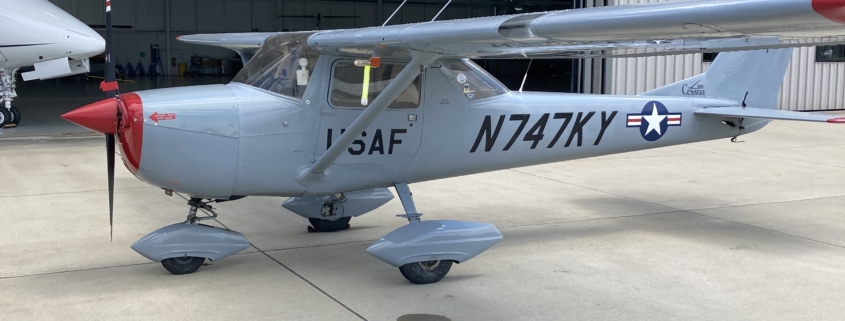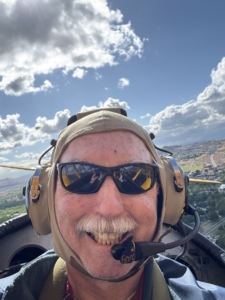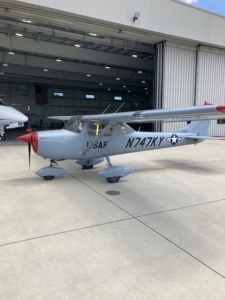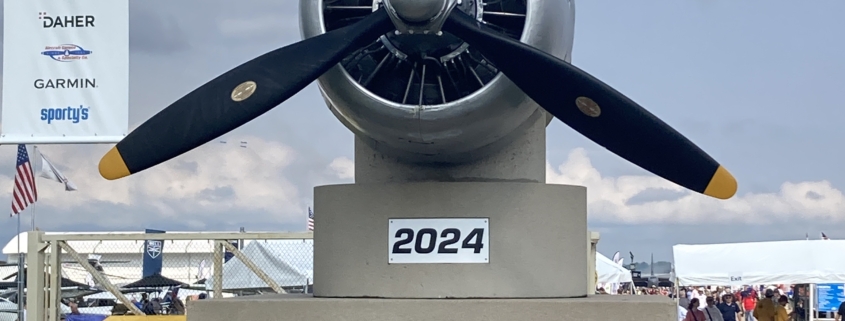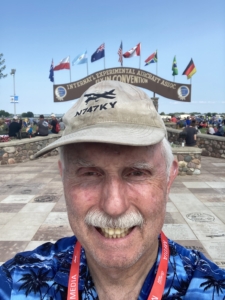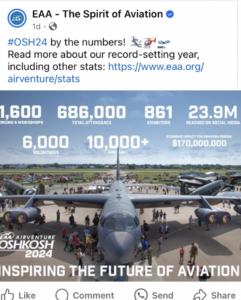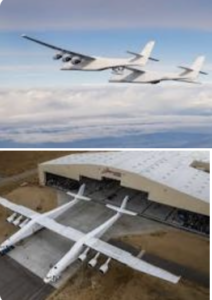AirVenture Oshkosh, are you going?
/0 Comments/by John Mahany
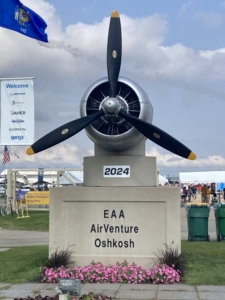 AirVenture Oshkosh is right around the corner!! Next week, starting on Monday, July 21! Are you going? It’s the ‘Mecca’ of aviation, the largest aviation gathering in the world! Are you flying yourself or taking an airline flight? Oshkosh is the world’s busiest airport for a week, every year, during the convention.
AirVenture Oshkosh is right around the corner!! Next week, starting on Monday, July 21! Are you going? It’s the ‘Mecca’ of aviation, the largest aviation gathering in the world! Are you flying yourself or taking an airline flight? Oshkosh is the world’s busiest airport for a week, every year, during the convention.
I’ve been there myself many times. And in 2022, I flew there in my 150, and I’ve flown in there with others as well, in their aircraft. It’s a challenge each time. You a HAVE to be on your ‘A’ GAME!! Seriously! So many airplanes converging on Oshkosh! Did you know that air traffic controllers from around the country bid to work ‘Oshkosh’ during the convention? Yes, they do! It’s a challenge for them, as well, managing or juggling the mix of traffic, as they all converge on ‘OSH’, from fast jets to slow props, and getting them lined up, with enough spacing, and all safely on the ground at Oshkosh….it’s quite a feat! And it’s amazing to watch, also!
And the flight planning for this is different, especially if you don’t go on a lot of long flights. If your typical flight is a local flight for breakfast or lunch, this is quite different! If you don’t normally deal with weather, this ‘trip’ will be different. You may encounter weather-related delays on the way, or even mechanical delays. Have you ever had to deal with that before? It might take you a few days of flying to get there, depending on where you start from. There are many things to consider. And quite a lot of decision making, or ADM (aeronautical decision-making) as pilots refer to it.
In fact, inadequate pre-flight planning and preparation are among the top ten causes of aviation accidents each year. Some here are some things to consider, depending on what kind of airplane you fly –
What’s the weather? IFR/MVFR/VFR?
How much fuel do you have? How many gallons per hour do you burn at cruise?
What’s your range? When and where do you plan to stop for fuel?
How do you check for weather? There are many sources now.
What’s your route of flight?
Do you find someone in another airplane to fly along with you, in loose formation? Some do, some don’t. I flew alone. On my own schedule. Easier for me that way.
Do you fly early in the morning, or later in the day, or at night? Depends on if you are a ‘morning person’ or a night owl?
These are all decisions that have to be made. And now, with so many pilots having electronic ‘devices’ that provide them with real-time weather information, they should have a better idea of the weather, and more. But many pilots still lack a good understanding of weather and make poor weather-related decisions as a result. And things still go wrong. The weather changes. And some pilots don’t get updates. The forecast winds change. And you have to be able to adapt to a changing situation. Some people stubbornly do not adapt well to changing situations, and they suffer the consequences.
The best general advice? Regardless of your experience, or the aircraft you are flying, BE CONSERVATIVE in your planning! Don’t ‘push it’. When I flew my Cessna 150 to Oshkosh, I planned a fuel stop about every 2 hours, give or take. Sometimes there was not a suitable airport at the 2-hour point, so I’d either land sooner, or continue onto a suitable airport. That helped considerably. My fuel gauges showed about ½ full when I landed for fuel. This is just one example. The regulations allow VFR pilots to land with only 30-minute reserve during the day. That is the minimum amount. That is not enough for me. I prefer an hour.
One other thing; I did NOT fly into the evening. Nope! I ONLY flew during the day, in good weather. I always landed by about 6pm, well before sunset, regardless. I did NOT push it, into the evening, with dusk approaching. Everything changes after dark. I speak from experience, having extensive night flying experience, when I was an airline pilot, some years, ago. That’s DIFFERENT! In a well-equipped turbine powered airplane, good avionics on board, etc. being part of a crew. Not alone.
About two months ago now, a Cessna Citation (jet) crashed short of the runway at San Diego’s Montgomery Airport, in the early morning hours, before the air traffic control tower was open, and all on board were killed in the crash! Unfortunately, the pilot decided to fly this approach even though he was probably fighting fatigue because he had been flying all night, the weather was not good, and there were some equipment problems at the destination airport. He should have diverted to another more suitable airport, with better weather, but foolishly, he did not. Several people died as a result. Accidents like this give ALL of us a bad name!
No one is typically around at smaller airports, non-towered airports, after dark. I did NOT take ANY chances, being alone, at a small airport, after dark, and then, just my luck, not be able to find the self-service fuel island, or the self-serve fuel kiosk may not work, etc. or the pilot- controlled lighting (PCL) may not work, etc. It’s happened before.
So, that’s my advice. Be conservative. Always have options! Have plenty of fuel, have daylight, carry some spares, and some basic tools. You are more relaxed and think much better when it’s like this! Seems obvious, but some chose not to follow this guidance. That’s their choice. I’ve learned, and am wiser for it. My bucket of ‘experience’ is growing with each hour that I fly. All part of it.
And this worked out well for me! Lots of planning, and I tried hard to avoid BIG surprises! Little surprises, I can handle. I am not flying my 150 to Oshkosh this year. My ‘gut’ feeling was to ‘not fly myself’ back this year. Nope. And my 150 has had some mechanical problems, as well, perhaps the result of being 50 years old? So, I have replaced the battery and the alternator. I’m flying back on the airlines. A goal is for me to get a bigger, more capable single-engine airplane, but I’m not there yet. I know what I want, but it’s beyond my financial means, right now.
By the way, I am planning on making videos each day while at AirVenture, in addition to taking pictures, and hope to post them on social media, like Facebook or Instagram. I will have to see how this works out. I will be too busy during the day, so hopefully in the evenings.
And, if you are in need of an experienced instructor to work with you, in YOUR AIRPLANE, improve your piloting skills, perhaps provide avionics training, or whatever you may want to work on, I AM available! Contact me for more information.
Fly safely!
John
FAA’s Coffee and Wings Webinar August 16; IFR SOPs
/0 Comments/by John MahanyOn Saturday, August 16, 2025, at 0900 CST, 0700 PST, John will present this as via zoom as a webinar for the FAA’s Coffee and Wings program, which is hosted by Laura Herrmann, in Minneapolis, MN. This will count for FAA Wings Credit. If you are interested in this webinar and want to get Wings Credit, go to www.faasafety.gov/SPANS/event to sign up.
In this presentation, John discusses what are referred to among professional pilots as Standard Operating Procedures, or SOPs. for short. This PPT addresses SOPs and how they can be applied when flying IFR in general aviation airplanes. However, VFR pilots can also apply some of these SOPs to their flying.
SOPs generally start before the flight, and continue throughout the entire flight, finally ending after landing, when you taxi in, park the airplane and shut down on the ramp. They provide guidance to the pilots during each phase of flight, so the pilot(s) know what is expected. This results in a safer operation overall.
See how you can apply these to your flying, to be a better, safer IFR or VFR pilot, whether flying single pilot (SP) or as part of a 2-pilot crew. Some are common-sense procedures, also known as ‘generally accepted industry practices’, that may vary, depending on the operator, but that result in conducting safer flight operations
EAA Chapter 1712; Riverside Airport, Aug. 5, FAA Safety Seminar
/0 Comments/by John MahanyJohn will be presenting to EAA Chapter 1712, at their monthly meeting, at Riverside Municipal Airport, in the Lobby of the Admin Building, on Tuesday, August 5, at 6:30pm. His topic; Airplane Checkouts – there’s more to it now.
There are many things to consider now, depending on the aircraft, and how its’ equipped. The goal is, what’s required to get a good, thorough check out, from an experienced and knowledgeable CFI, in a different make and model aircraft than what you have flown before, so that you will be a good, safe, competent pilot.
John is a long time CFI and has flown a wide variety of aircraft over the years, so he has some valuable tips to pass on to pilots when they decide to get checked out in a new aircraft.
Engine Failure After Takeoff!!
/7 Comments/by John MahanyEngine failure after takeoff!!
It’s been a long time, many months, since last year, August 2024, that I last posted anything here. My excuse? I’ve just been busy with lots of stuff! Life gets in the way. Now, I want to get back to it. And, hopefully, on a regular basis!
It’s been a bad year so far for aviation! We’ve been in the news since nearly the first of the year with several aircraft accidents, all unrelated! What is going on?? It’s many different things. My goal in writing this blog is to try to contribute and make a difference, however small it may be, towards safer pilots, and safer skies.
I feel a strong sense of obligation to pass onto other pilots some of what I have learned, to help them improve their aviation knowledge and piloting skills, and become better, safer pilots. This is the reason that I am a flight instructor, or CFI, and provide training to pilots.
And if I can help just one pilot to learn something from my writing, then it is worthwhile! I cannot sit quietly on the sidelines, as things happen. Nope. But I haven’t been. I’ve been actively involved with many things. I just have not found the time to comment. But that has to change. Thus, I am restarting this blog, writing about my various flying adventures and lessons learned along the way, along with commenting on the aviation industry and safety trends when appropriate, in hopes that it can and will benefit some aviators, somewhere.
And on Saturday. May 24, 2025, something quite unexpected happened as I was departing Riverside, California, intending to fly back to Long Beach, in my Cessna 150.
But a brief backstory is in order, first. The airplane had been ‘down’, not flyable, for 3 weeks starting in late April, during the required yearly, hence the term, ‘annual’, maintenance inspection. Yep, it’s an FAA requirement for ALL aircraft, whether jets, props, gliders or whatever, that they be inspected by an FAA certified mechanic (A&P) aka Airframe and Powerplant Mechanic, who does the work, and an I/A (inspector) who inspects and ‘signs off’ the work if done properly, and attests that it is airworthy. This is to make sure they are ‘safe to fly. Makes sense. As far as I know, aircraft mechanics are the only ‘government certified’ mechanics’.
My mechanic had discovered a few things that needed to be fixed or replaced. And that took some time. Finally, after 3 weeks, it was airworthy again! Yeah!
So, on Friday, May 23, I drove to the airport where N747KY is tied down and did a preflight inspection to get it ready for a short maintenance test flight. And I had it fueled, so I was starting out with full tanks. It would only be a short flight, ‘once around the pattern’ as we say. Just to make sure everything is working. The test flight was uneventful, as expected.
The next day, I planned to fly it about 40 miles east to Riverside Airport, for what is called ‘display day’. The state of California tax assessor has declared that aircraft and marine vessels, more than 35 years old, are considered ‘vintage’. If they are properly ‘displayed’ for public viewing, 12 times a year, at designated locations and get a ‘signoff’ attesting to that; then the owners are exempted from paying the property tax on the aircraft or vessel. The property tax is equal to 1% of the value of the aircraft or vessel. It can add up!
So, I flew uneventfully to Riverside Airport, identifier KRAL, and landed, and got my paperwork signed off. There was actually a good turnout on the ramp, with many airplanes being displayed, and I chatted with some of the pilots. It was fun to see the various vintage aircraft from days gone by.
Then I got ready to leave, and started up and taxied to the run-up area, and did the run-up and pre-takeoff checks. So far, so good. Then I taxied to runway 27 (magnetic heading 270°, aka west) and waited for my takeoff clearance. Once cleared for takeoff, I taxied onto the runway centerline and smoothly applied full power. Everything was normal, accelerating down the runway. Reaching rotation speed, I applied back pressure and took off, starting to climb. It was accelerating and climbing out normally. And then suddenly, at about 200’ above the ground, the engine suddenly sputtered and a glance at the RPM (tach) showed it was fluctuating wildly, varying 500 – 700 RPM!!, and then just as suddenly, the engine stopped, and the RPM dropped down to 0! Zero!?! OMG. This was a first! I’ve never had this happen, for real, in 40+ years of flying! But I’ve practiced simulated engine failures many, many times over the years, in a variety of aircraft, during countless training flights and simulator training sessions. So, I know the drill, though it varies, depending on the aircraft.
Ok, I could see runway ahead (I had taken off on the long runway), so this had happened in an ideal place! I was not somewhere over inhospitable terrain or a congested urban area. That would be bad. I could make a safe uneventful landing on a runway! God is my co-pilot! The obvious thing to do was to land straight ahead on the remaining runway! Fortunately, this had not happened 30 seconds or 1 minute later! Then I would have flown beyond the airport boundary. That could have changed the outcome.
I immediately lowered the nose and as the engine had stopped producing power at this point, to maintain airspeed, and I silently glided/descended towards the runway. Oh, and I had the presence of mind to make a radio call to the Riverside (ATC) Control Tower, telling them, as I recall; ‘7KY engine failure landing straight ahead’ and then I focused on landing. I don’t even recall if they responded. A few seconds later I flared, landed and was on the ground, rolling out at a high rate of speed but slowing since there was no power now and the propeller had stopped rotating.
I was approaching the intersection of a crossing runway that was not in use, runway 16/34 and turned left onto it, and continued left onto a taxi way, then turned right, and stopped on the ramp.
By now the tower had called me and asked if I needed any assistance. I told the tower to stand by (in ATC lingo, that means the pilot is busy and unable to reply; the priority is to FLY THE AIRPLANE), and I’d get back to them.
I had not declared an emergency. I just sat there for a minute and tried to figure out what had happened. Why had the engine suddenly failed, after running normally and getting me to Riverside? Hmm.
I attempted to restart the engine 2 or 3 times. It ran briefly then stopped, each time. Perhaps a problem with the fuel? Hmm. What could it be? I tried starting again and this time it started, and continued running, so I called Riverside Ground Control and requested taxi back to the transient ramp, where I wanted to park the airplane.
Once parked, I texted a pilot friend at another airport to see if he might be able to fly to KRAL to pick me up, if needed, to fly me back to Long Beach. And then I called my mechanic who had just done the ‘annual’ inspection. I had expected to leave a voicemail, but he answered! I explained what had happened. Frank listened and was equally surprised. He decided to drop what he was doing and drive to Riverside Airport to find out what had happened. I decided to have lunch at the airport café and wait for him.
90 minutes later he arrived. LA freeway traffic can be bad, even on a weekend. We went out to the airplane. I had ‘sumped’ the fuel again, taking a small sample and checking for water in the fuel. It happens. Water can sometimes get into the tanks, the result of condensation, leaks and sometimes during refueling. And water is heavier (8#/gal.) than avgas (6#/gal), so water is on the bottom in a fuel strainer, easier to see. And avgas, as aviation gasoline is called, is dyed light blue so it is not confused with other fuels. Jet fuel, aka Jet-A, is clear by comparison. The wings tanks showed no sign of water. But the engine sump was different. Being the low point in the system. I had checked it but did not see any water. Turns out I did not check it enough.
When Frank got there, we opened the cowl and I pulled the spring-loaded fuel drain ‘tab’ on the top of the engine, and Frank had a clear plastic cup down below. The fuel from the low point in the system drained into that. And now we could see water in the fuel. At least ½ cup of water, or more!! The culprit! For some reason, water particles had gotten into the fuel and had been suspended in the fuel. But now we could see them. And we continued to drain fuel into the cup. We could see more water. For any number of reasons, this had happened.
We continued to drain fuel until there was no more water showing. Then Frank suggested I start the engine and just sit there and run it for a few minutes, to see how it ran. So, I did that, adding and reducing power a few times, and it ran fine. No more water in the fuel. Then I shut it down and we checked one more time for water in the fuel. None showing. So, then I started up and taxied out and then took off and flew once around the airport, landed, then taxied in. Frank was there waiting. I gave him a thumbs up and taxied back and took off and flew uneventfully back to Long Beach. Finally!
We suspect that the fuel truck had not been properly checked for water in the tank, and when I had the airplane fueled on Friday morning before the test flight, it was actually fueled with some contaminated fuel. But it took 2 flights in my airplane before it showed up. And even though I did sump the tanks, checking for water contamination, but it had not shown up, yet. So, more lessons learned. Always something.
Fly safely!
John
AirVenture 2024! – IF you missed it, it was AWESOME!!
/by John MahanyIt’s wrap! AirVenture ended on July 28th, and it’s a week later already. But it stays with you!! I’m STILL jazzed up about it!! And this past week has been excellent, as well! I’m on a roll!! Wahoo!! So many aviation activities!!
On Wednesday, I had signed up with the Aero Club of Southern California to take a tour of the Mojave Air and Space Port, at Mojave Airport, in Mojave, CA, about 100 miles north of LAX, up in the Mojave Desert. This includes Scaled Composites and the National Test Pilot School. Cool stuff like the Stratolaunch, shown here; a one-of-a kind 6 engined behemoth, designed by iconic aircraft designer Burt Rutan, used to carry manned air-to-launch rockets that you simply don’t see anywhere else!
Then on Thursday, from 12 – 2pm, an FBO (Fixed Base Operator), ACI, at John Wayne Airport hosted an outdoor ‘Summer Mixer’, with free food, drinks and live music in one of the ‘hangar alleys’ (a row of hangars) on the airport. I saw several friends there, of course. Then Friday night was a ‘TGIF’ dinner with a group of my pilot friends who meet weekly for dinner at various restaurants in Orange County, and we naturally talk airplane stuff, and then on Saturday, the yearly Del Amo Flyers hangar party, at Torrance Airport. What a blast!! This is one of many aviation organizations that I belong to. It’s all fun! One of the members opens his hangar for this. A whole lot of fun! What a week!!
So, back to Oshkosh; there is just so much to see and not enough time!! And it’s the people as well! I have friends and colleagues that I only see once a year in Oshkosh! I keep saying that, BUT it’s TRUE!! It’s Disneyland to the MAX for aviators and aviation enthusiasts!! I go all day every day for 6 days, and I’m NOT worn out at the end. I still have plenty of energy. AirVenture energizes me!!
The final numbers from EAA are in, for the week. Total attendance, 686,000!! From around the world! 1,600 seminars and workshops!! The graphic at left was posted on Facebook by a friend.
It’s simply amazing, and in spite of the large numbers, the crowd is well mannered and respectful, and you don’t see any litter on the grounds. It’s NOT like a rock concert, with crazy out of control fans. Nothing like that.
When asked, what was my favorite thing? I DON’T have an answer. There are so many things. The daily airshow? The aircraft on static display? The USAF F-35 Raptor doing a fly-by with afterburners on and the ear shattering sound of the burners?? Or the Wednesday night airshow? The world-class museum? Some of the speakers? Vendors with cool new gadgets? Or the new tech stuff on display in the Garmin Exhibit, just to name a few things. It’s hard for me to choose.
I also did a lot of networking, of course, and that went well also. I had signed up to attend several dinners, Monday thru Thursday. I am trying to ‘stir up trouble’ in a good way, hoping that I can find new opportunities for work! This is THE place to meet people, in person, instead of online. I think that went well. Time will tell.
So, a crazy busy fun 2 weeks now!!
Finally, I am available IF you are in need of any flight or ground training for anything, please let me know.
Fly safely!
John
AirVenture 2024!
/by John MahanyDateline Oshkosh Wisconsin & AirVenture
EAA AirVenture 2024 is underway! Under clear skies, EAA AirVenture Oshkosh got underway on Monday. I was up at 5am to make sure I was there in time. I am staying about 25 miles away in the dorms at Ripon College this year. The UWO dorms were full.
Monday was my day to just see as much of it as I could see, because starting Tuesday I will be volunteering for 2 organizations, SAFE and FAN. SAFE is the Society of Aviation and Flight Educators, of which I was a founding member, back in 2009. FAN is the Florida Aviation Network, which is a non-profit aviation media organization that I got involved with about 10? years ago. They arrange for me to get media/press credentials and admission to the convention.
This week it is expected that over 600,000 people will attend! There is so much to see, with over 10,000 aircraft parked on the grounds, as well as seminars, workshops, aircraft doing fly-bys, along with nearly 800 exhibitors, and more. And a daily air show that starts at 3pm each day. You simply cannot take it all in! The event planners outdo themselves every yea! And EAA also has a number of trams that provide transportation around the grounds, driven by volunteers. There are over 5,000 volunteers that make AirVenture happen.
According to the health app on my iPhone, on Monday I walked over 17,000 steps, just over 7 miles! Easy enough to do. The flight line, all of the rows of parked aircraft, is more than 5 miles long!
It’s a busy, fun week, connecting with fellow aviators from all around the world. I’ve been to AirVenture as it is now called, at least 25 times, and there’s something new to see every year. It never gets old!
Fly safely,
John

